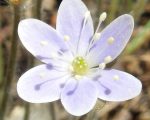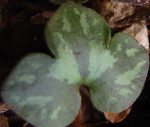 Known as one of the earliest flowers to bloom in the spring, American liverwort is a herbaceous perennial and member of the buttercup family, Ranunculaceae, that also includes columbine, hellebore, and delphinium. It is not related to true liverworts, that are very simple plants more closely related to mosses. Plants grow six to eight inches tall and have stems covered with silky hairs and large basal liver-shaped leaves up to three inches long with three rounded lobes. White to light blue and lavender flowers have six to ten petal-like sepals subtended by 3 hairy bracts and ½ to 1” across. American liverwort is native to hardwood forests and forest edges in Eastern North America from Ontario to the Gulf. The genus name Hepatica from the Greek word hepar meaning liver, referring to the shape of the leaf. The genus name, Anemone, comes from the Greek word, anemos, meaning wind. The specific epithet, americana, refers to the geographic distribution of the plant.
Known as one of the earliest flowers to bloom in the spring, American liverwort is a herbaceous perennial and member of the buttercup family, Ranunculaceae, that also includes columbine, hellebore, and delphinium. It is not related to true liverworts, that are very simple plants more closely related to mosses. Plants grow six to eight inches tall and have stems covered with silky hairs and large basal liver-shaped leaves up to three inches long with three rounded lobes. White to light blue and lavender flowers have six to ten petal-like sepals subtended by 3 hairy bracts and ½ to 1” across. American liverwort is native to hardwood forests and forest edges in Eastern North America from Ontario to the Gulf. The genus name Hepatica from the Greek word hepar meaning liver, referring to the shape of the leaf. The genus name, Anemone, comes from the Greek word, anemos, meaning wind. The specific epithet, americana, refers to the geographic distribution of the plant.
Type: Herbaceous perennial
Bloom: White to light blue and lavender flowers with six to ten petal-like sepals subtended by 3 hairy bracts and ½ to 1” across, in early spring
Size: 6-8” H x 6-8” W
Light: Partial shade
Soil: Humusy, consistently moist, well-drained, alkaline
Hardiness: Zones 3-8
Care: Low maintenance
Pests and Diseases: None of significance
Propagation: Seed; division in spring
Companion Plants: Snowdrops, crested iris, crocus